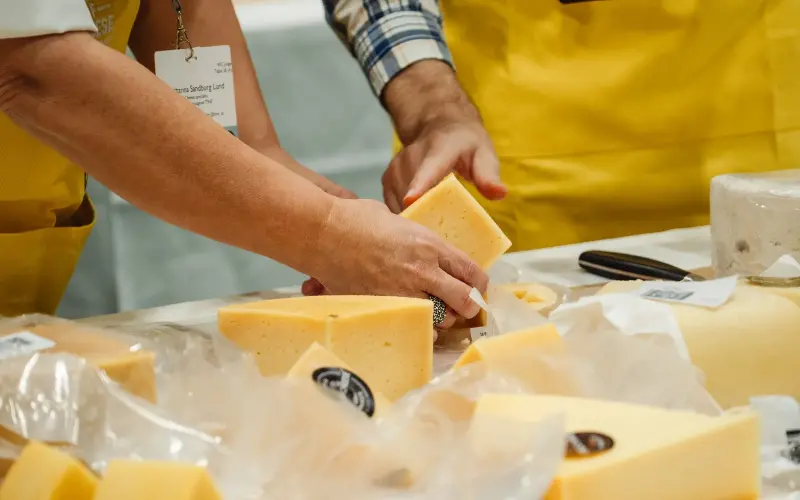
It may have been built with Eurovision in mind, but on Wednesday the Festhalle in Bern, Switzerland, played host to a far more important occasion – for turophiles. For the first time in the event’s 37 year history, the World Cheese Awards took place in Switzerland, in many people’s eyes the home of cheese.
It may come as no surprise that a home cheese won. For the second time in four years, a gruyère was named the world’s best. With a beautiful dark orange rind and powerful umami notes, the 18-month aged cheese (catchily named Gruyère AOP Vorderfultigen spezial) overcame stiff competition, including from three British cheeses in the top 14.
For three days, Switzerland’s capital became the capital of cheese, with a record 5,244 entries (the first time the 5,000 barrier has been broken) from 46 countries and hundreds of global experts, from cheesemakers and mongers to importers, affineurs, writers and cheese-loving comedian Marcus Bridgstocke, convening to crown this year’s best fromage.
Cheese writer Patrick McGuigan praised the winning cheese, describing the aroma as having “a real beefiness”. He said: “When you taste it it’s savoury, it’s deep, it’s umami.” Perry Wakeman, a head judge at the awards, chief executive of cheesemonger Rennet & Rind and widely considered Britain’s best affineur, said the cheese was familiar, like all the Swiss alpine cheeses many will have tried, “but dialled up to 13”. He said: “It’s a big old cheese. The texture is beautiful, flinty, the crystals are so delicate. I kept going back for it. It’s the kind of cheese that gets people into cheese. I think that’s what makes this cheese special, it would get people excited about cheese from whatever walk of life.”
Pius Hitz of Bergkäserei Vorderfultigen, which makes the winning cheese, described himself as “honoured” and “proud”. Considering almost 20 per cent of the entered products were locally made, it really was no shock that a Swiss cheese won; in the end, four Swiss cheeses were listed in the top six.
While the World Cheese Awards are often criticised for a strong showing from the home country – the host has won five of the past seven events, one outlier being a champion gruyère in Wales in 2022 – local cheeses, having travelled less distance, often arrive in better condition. Last year, despite not winning, two Swiss alpine cheeses finished joint second, and they are usually present on the podium.
Britain has arguably one of Europe’s most thriving cheese industries, and after being entirely absent from the event in 2024, three of its cheeses were recognised in the top 14 this year. Pave Cobble, a soft sheep’s milk cheese from White Lake in Gloucestershire, scored highly, as did Sparkenhoe Red Leicester.
But it was another Leicestershire cheese, aged Rutland Red from Long Clawson Dairy, that was Britain’s top cheese, finishing joint eighth. McGuigan described it as having an “amazing colour, sort of sunset red”. He added that the flavours were “interesting, quite a lot of yogurt and acidity, a bit of roasted nuts, it was quite fresh”. According to Canadian judge Nick Tsioros, “the complexity of flavours was really nice, it was sharp, caramel, nutty; it inspired me to want to eat more”. While no British cheese has won outright since 2017, when Cornish Kern was victorious, they are a routine fixture in the top spots.
Throughout the day, the 265 judges from 46 countries were split into teams of two or three, each sampling around 45 cheeses. I was one of them, evaluating the entries on appearance, texture, aroma and, primarily, taste, and handing each cheese a bronze, silver and gold medal – or nothing at all.
Judging alongside a Swiss cheesemaker and a Uruguayan cheese expert, I faced a mixed bag at our table. One had a vaguely toilet-like ammonia whiff, while a Swiss tête de moine (judging is blind, but with some cheeses it’s obvious) was style over substance. One truffle-flavoured number was awful, with a crumbly texture somewhere between Styrofoam and rice cakes. A jet black, charcoal-enriched cheese was an abomination.
But there were hits, too. A tiny, camembert-style cheese made with sheep and goat’s milk was a delicate delight, and a litany of Swiss mountain cheeses impressed. Each of the 110 tables must pick a super gold, to be judged by the super jury, and our table deliberated between two finalists, a sweet, nutty alpine cheese and a rather unique hard cow and goat’s cheeses washed in cider – you could taste the booze in the cheese. Ultimately, the more classic (and probably Swiss) option won out.
Each year, there are more – and more interesting – cheeses. From blue cheeses coated in dark chocolate to cheeses flavoured with all sorts of herbs and spices, there is an experimental streak taking hold in the cheese world, and a petal-coated soft French cheese scored highly, finishing second.
John Farrand, the managing director of the British-based Guild of Fine Food, which organises the event, said: “The host country scoops the biggest prize in cheese again. Perhaps it is that our judges are immersed in the terroir of the nation, perhaps it is the simple fact that the cheese has less far to travel, but the reality is that this cheese has won through our multi-layered and robust blind-tasting judging process and ended up achieving the highest score, impressing the super jury from 14 different nations.”
Farrand added he was delighted by Britain’s strong showing, after none of its cheeses made last year’s event in Portugal due to Brexit-related border issues. “It’s perhaps an indication that British cheesemakers continue to not only innovate but consistently make high quality cheeses that are impressing the judges.”
